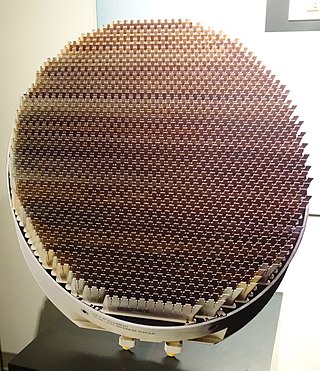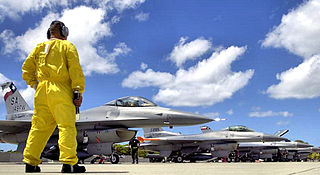Notes
- ↑ Thailand Royal Air Force Handbook Volume 1 Strategic Information and Weapon Systems. IBP, Inc. 2007-02-07. ISBN 978-1-4330-4913-2.
Emerson Electric's AN/APG-69 is an X band coherent pulse doppler radar originally designed for the F-20 Tigershark aircraft. It is the successor to the AN/APQ-159. [1] Northrop skipped over the APG-69 for the F-20, choosing the General Electric AN/APG-67 instead. The APG-69 was still used by other F-5 operators, and other light fighter projects, including the ALR Piranha.
The APG-69 offered a complete suite of air-to-air and air-to-ground modes. The air-to-air modes included velocity search for long-range wide-angle searches, track-while-scan, single target track and dogfight modes that automatically locked onto the closest target. The APG-69 was capable of guiding the AIM-7 Sparrow missile, making it the first of Emerson's offerings to reach production with beyond visual range capabilities. The air-to-ground modes included moving target search and track, and sea-surface-search modes.

The McDonnell DouglasF-15E Strike Eagle is an American all-weather multirole strike fighter derived from the McDonnell Douglas F-15 Eagle. The F-15E was designed in the 1980s for long-range, high-speed interdiction without relying on escort or electronic-warfare aircraft. United States Air Force (USAF) F-15E Strike Eagles can be generally distinguished from other US Eagle variants by darker aircraft camouflage, conformal fuel tanks (CFTs) mounted along the engine intake ramps and a tandem-seat cockpit.

The Euroradar Captor is a next-generation mechanical multi-mode pulse Doppler radar designed for the Eurofighter Typhoon. Development of Captor led to the Airborne Multirole Solid State Active Array Radar (AMSAR) project which eventually produced the CAESAR, now known as Captor-E.

An active electronically scanned array (AESA) is a type of phased array antenna, which is a computer-controlled antenna array in which the beam of radio waves can be electronically steered to point in different directions without moving the antenna. In the AESA, each antenna element is connected to a small solid-state transmit/receive module (TRM) under the control of a computer, which performs the functions of a transmitter and/or receiver for the antenna. This contrasts with a passive electronically scanned array (PESA), in which all the antenna elements are connected to a single transmitter and/or receiver through phase shifters under the control of the computer. AESA's main use is in radar, and these are known as active phased array radar (APAR).

The AN/APG-66 radar is a solid state medium range pulse-Doppler planar array radar originally designed by the Westinghouse Electric Corporation for use in early generations of the F-16 Fighting Falcon. This radar was employed in all domestic and export versions of the F-16 A/B models throughout the production. Subsequent upgrades have been installed in many varying aircraft types, including the U.S. Customs and Border Protection's C-550 Cessna Citation, US Navy P-3 Orion, and Piper PA-42 Cheyenne II's, as well as the Small Aerostat Surveillance System (SASS). Primary air-combat mode is look-down. In that mode, the AN/APG-66 can detect a fighter-size plane at a range of 34.5 Nautical miles. Four modes are available in air-to-air combat. In dogfight mode, the radar scans a 20 degrees x 20 degrees field. In high-g maneuvers, it scans a 40 degrees x10 degrees pattern. The radar system consists of the following line-replaceable units:

The AN/APG-63 and AN/APG-70 are a family of all-weather multimode radar systems designed by Hughes Aircraft for the F-15 Eagle air superiority fighter. These X band pulse-Doppler radar systems are designed for both air-air and air-ground missions; they are able to look up at high-flying targets and down at low-flying targets without being confused by ground clutter. The systems can detect and track aircraft and small high-speed targets at distances beyond visual range down to close range, and at altitudes down to treetop level. The radar feeds target information into the aircraft's central computer for effective weapons delivery. For close-in dogfights, the radar automatically acquires enemy aircraft and projects this information onto the cockpit head-up display. The name is assigned from the Army Navy Joint Electronics Type Designation System.
The AN/APG-65 and AN/APG-73 are designations for a family of all-weather multimode airborne radar systems designed by Hughes Aircraft for the F/A-18 Hornet, and used on a variety of fighter aircraft types. The APG-79 is an upgraded AESA version.

The AN/AWG-9 and AN/APG-71 radars are all-weather, multi-mode X band pulse-Doppler radar systems used in the F-14 Tomcat, and also tested on TA-3B. It is a long-range air-to-air system capable of guiding several AIM-54 Phoenix or AIM-120 AMRAAM missiles simultaneously, using its track while scan mode. The AWG-9 utilizes an analog computer while the APG-71 is an upgraded variant utilizing a digital computer. Both the AWG-9 and APG-71 were designed and manufactured by Hughes Aircraft Company's Radar Systems Group in Los Angeles; contractor support was later assumed by Raytheon. The AWG-9 was originally created for the canceled Navy F-111B program.

The AN/APG-77 is a multifunction low probability of intercept radar installed on the F-22 Raptor fighter aircraft. The radar was designed and initially built by Westinghouse and Texas Instruments, and production continued with their respective successors Northrop Grumman and Raytheon after acquisition.
The AN/APG-76 radar is a pulse Doppler Ku band multi-mode radar developed and manufactured by Northrop Grumman.
Radar Doppler Multitarget is a multimode Look-down/shoot-down Pulse-Doppler radar designed by Thomson-CSF for the Mirage 2000-5 fighter. The RDY-3 derivative has been fitted to Moroccan Mirage F1's. Thomson has claimed that the original RDY outperformed the AN/APG-66/68 of the F-16 and the AN/APG-65 of the F/A-18 Hornet.
The AN/APG-80 is an Active Electronically Scanned Array (AESA) system designed and manufactured by Northrop Grumman for use on the Lockheed Martin F-16 Fighting Falcon fighter aircraft. It was originally designed to be included on the F-16C/D Block 60 Desert Falcon aircraft ordered by the United Arab Emirates, subsequently reclassified as the F-16E/F Block 60 Desert Falcons; first deliveries were made in 2003.

The AN/APG-81 is an active electronically scanned array (AESA) fire-control radar system designed by Northrop Grumman Electronic Systems for the Lockheed Martin F-35 Lightning II.

The 149th Fighter Wing is a unit of the Texas Air National Guard, stationed at Kelly Field Annex, Joint Base San Antonio, Texas. If activated to federal service, the Wing is gained by the United States Air Force Air Education and Training Command.
The Emerson Electric AN/APQ-159 was an I band/J band radar designed to upgrade Emerson's simple AN/APQ-153 used in the Northrop F-5. It offered roughly double the range, increased off-boresight tracking angles, and considerably improved reliability. Originally intended to be replaced by the further improved AN/APQ-167, modernized F-5s have typically moved to the entirely new AN/APG-69 instead.
The AN/APG-67 is a multi-mode all-digital X band coherent pulse doppler radar originally developed by General Electric for the Northrop F-20 Tigershark program of the early 1980s. It offers a variety of air-to-air, air-to-ground, sea-search and mapping modes, and compatibility with most weapons used by the US Air Force in the 1980s.
The RDM (Radar Doppler Multifunction), also known as the Cyrano 5, is a French multimode pulse-Doppler radar developed by Thomson-CSF (now Thales) for export variants and early French models of the Mirage 2000 fighter aircraft. It is an evolution of the Cyrano IV installed on the Mirage F-1 and in turn was developed into the RDI (Radar Doppler à Impulsions), a specialist air-to-air radar for French Mirage 2000 interceptors, and the multimode RDY (Radar Doppler Multitarget), which could track more targets at a time and added further air-to-ground modes.

The AN/APQ-120 was an aircraft fire control radar (FCR) manufactured by Westinghouse for the McDonnell Douglas F-4E Phantom II. AN/APQ-120 has a long line of lineage, with its origin traced all the way back to Aero-13 FCR developed by the same company in the early 1950s. A total of half a dozen FCRs were tested and evaluated on the first 18 F-4s built, but they were soon replaced by later radars produced in great numbers, including AN/APQ-120.
The AN/APG-85 is an active electronically scanned array (AESA) radar system designed by Northrop Grumman for the Lockheed Martin F-35 Lightning II. The AN/APG-85 is a further development of the AN/APG-81 and is planned to be installed in all three variants of the F-35 aircraft from Lot 17 and onwards, which are planned to enter production in 2025.